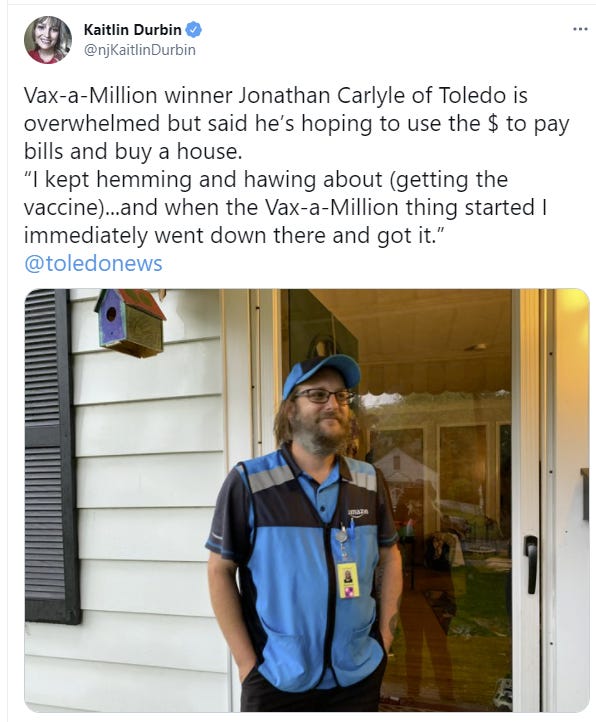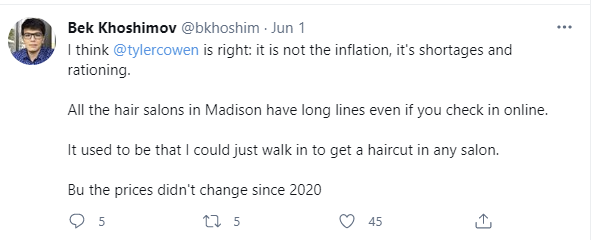Covid 6/3: No News is Good News
Infections and deaths continue to decline. There is no sign that the change in mask policy or anything else is going to blunt that, or that the control system is attempting to reassert itself. We’re winning.
If you’re reading for ‘news you can use’ there isn’t any beyond ‘news is good.’ It's safe to relax.
That does not mean that we’ve won quite yet. That will take time, and there’s the danger of new variants being able to spread sufficiently well among the unvaccinated to give us another scare, or potentially a future variant could be a threat to the vaccinated and we might not respond in time. It could happen. I don’t think it is likely.
Rest assured the world has plenty of other problems. I won’t be talking about them here and now, but there was plenty to fret before Covid-19, and there will be plenty after Covid-19.
There’s also the continuing issue of the lab leak hypothesis, the ways this has been handled, and the question of how to prevent future events of that type even if this turns out not to have been one of them. I’m not going to address that this week, but likely will address it again in the near future. On reflection getting this right seems important, but I am not in a place to do that today.
In the meantime, let’s run the numbers.
The Numbers
Predictions
Prediction from last week: Positivity rate of 2.2% (down 0.3%) and deaths fall by 9%.
Result: Positivity rate of 2.1%, deaths fall by 14%.
Prediction for next week: Positivity rate of 1.8% (down 0.3%), deaths fall by 12%.
Straightforward enough.
Deaths
I removed 500 deaths from Maryland since that was clearly a backlog of previous cases. That put us ahead of the path I projected, which was a good result but on reflection was also me being slightly too pessimistic. Steady declines across the board.
DateWESTMIDWESTSOUTHNORTHEASTTOTALApr 15-Apr 21883987174711684785Apr 22-Apr 287521173160911104644Apr 29-May 5943122014409714574May 6-May 12826106913928554142May 13-May 19592119412778113874May 20-May 2661594812796313473May 27-June 252783811704562991
Cases
I want to believe that these numbers are real, with dramatic declines everywhere but in the West. The state numbers look like what you’d expect to see if it was real, with California being one of the few places that got worse rather than better. This is such an insanely great result, to the extent that I have doubts it is fully real, as new vaccinations can only be a small effect and people’s behaviors are presumably less cautious rather than more cautious. Even if it’s fully real, it should make us worry more about seasonality. Still, good news is indeed good news.
DateWESTMIDWESTSOUTHNORTHEASTTOTALApr 22-Apr 2854,88788,97397,48278,442319,784Apr 29-May 552,98478,77885,64168,299285,702May 6-May 1246,04559,94570,74046,782223,512May 13-May 1939,60145,03063,52934,309182,469May 20-May 2633,89034,69448,97324,849142,406May 27-June 231,17220,04433,29314,66099,169
The situation in India continues to improve, and it no longer requires its own section to track the numbers there. I will keep an eye in case that changes.
In Other News
Marginal Revolution reminds us about partial dosing. I’d go a step beyond this and point out that it seems likely the Moderna dose is actively too high, resulting in the day after the second dose sucking more than it needs to. We could plausibly not only increase our supply of doses substantially with almost no reduction in effectiveness, we can likely net benefit as well, especially in reducing vaccine hesitancy. A lot of people who are still hesitant are worried about getting (or at this point, justifying) a day off of work that could mostly be an unforced error.
Canada moves to give people who got first shots of AZ second shots of Pfizer or Moderna, a highly efficient allocation of vaccine resources.
If you’re reading this in America you’re almost certainly vaccinated, but in case you’re not or know someone who isn’t:
Post on the early UK plan to aggressively pursue herd immunity, and how the media has rewritten history to pretend that the plan never existed or wasn’t a plan for herd immunity. It looks at several of the ways in which journalists are pulling off this memory hole. Repeatedly we’ve seen the words ‘herd immunity’ change in definition to suit elite preferences, and the fact that having been infected makes one immune is almost entirely being ignored. A lot of why we have this memory hole is the counter-framing of ‘people scheduled to die’ or otherwise painting the plan as inhuman supervillainy. The plan was wrong and it is good that it was abandoned before it did too much damage, in large part because perceptions of such plans made them unsustainable but also because the math didn’t work (in a way not very correlated with whether the plan could be socially and politically sustained).
Do vaccine lotteries work? This is the second winner of Ohio’s version:
That doesn’t mean there are that many similar people, but it’s a very good sign.
At least some places are determined to finally beat the control system. In other news, I am confused how certain people continue to reside in San Francisco.
What’s the inflation rate? Depends how you count, and here’s one more angle.
A hedonic adjustment seems in order. One concern is that the CPI makes ‘hedonic adjustments’ to inflation indexing when products and services improve (TV gets bigger), but mostly doesn’t when they get worse (plane shrinks your seat), and to get an accurate answer one must pick a side. Another way to view this is that we are shifting in some cases from the efficient allocation of goods and services mostly via price, to a system where we allocate those goods and services less by price and more by time spent, which destroys the time.
The optimistic take on time allocation is that it is temporary. There’s more demand for haircuts because there’s a backlog of people in urgent need of a haircut, while salons are still restaffing, so demand exceeds supply for now but that’s temporary, and customer (often long-term) anger would result from temporary price hikes, because people have this idea of what things ‘should’ cost. That results in me taking a trip to New York City that costs hundreds of dollars where I’m super excited to consume a fresh New York bagel, or choosing an exact location where I live with an eye to the quality and distance of the new local bagel shop, and then that bagel costs me roughly one dollar because that’s what it is ‘supposed’ to cost, and they hope to make their money on the creme cheese and lox, which are ‘allowed’ to cost more.
Uber ‘price surges’ always got people angry but meant both that there were more rides available when they were needed and that the right people did or didn’t get rides, but also that always pissed people off. Uber rides are also one of the things whose price has indeed risen to meet new market dynamics. Perhaps we need a mechanism that allows allocation by price with plausible deniability. Scalpers do this for concert tickets, and get paid a large percentage of the revenue for doing so. What if you could own your own scalpers but no one knew?
The pessimistic take is that a bunch of things where this dynamic does not hold back prices, like lumber, are seeing very high price rises, and thus prices are being artificially held down. As usual, it’s too soon to tell.
Another piece of evidence that newer variants, while sometimes more infectious, show no sign of overcoming the vaccines. Ratio of infections in vaccinated versus unvaccinated are similar to the ratios for previous variants.
Additional evidence the Chinese vaccine isn’t that effective, but also remember that a year ago we would have been thrilled to get 70% effectiveness.
Thread on the recent rise in cases in the United Kingdom (full of excellent graphs), which follows a similar pattern. B.1617.2 is fueling a new wave of Covid infection in many parts of the UK, which has seen case counts double in the last two weeks, rising to match the average new rate in the USA. The good news is that the new hospitalizations are among younger groups that are less vaccinated, and the vaccines appear to be holding strong. Then contrast that with this other thread on the UK situation, which notes the troublesome rise without considering the impact of vaccinations. Case numbers likely (80%+) will continue to get worse in the UK before they start improving again, but absolute numbers remain relatively low and the vaccinated remain mostly safe.
Peru updates its historical Covid-19 death counts, they now match its excess death counts. Indicates that Peru did very badly, and is a big update towards death counts being strong estimates of Covid-19 deaths despite all the reasons they should be inaccurate in various directions.
Vaccine trials for children are massively oversubscribed, showing parents do care.










